Chartres Controversy
/There is an article this week on the New York Review of Books blog entitled A Scandalous Makeover at Chartres by Martin Filler (and a subsequent follow-up) that is generating quite a bit of discussion. The makeover in question is the painting over of the interior stone. My own reaction follows most that I have seen online, namely something like "WTF, srsly?" It is almost inconceivable that such a drastic measure would be proposed, let alone approved or executed, in such a valuable site of religious and cultural heritage. Given my inclination to be contrarian, and interested in (but also suspicious of?) my own reaction, I want to poke at the outrage a bit.
Here is another opinion on the matter:
Without doubt, Our Lady of Chartres is still a majestic and sublime edifice. But for all the beauty she has maintained with age, it is difficult not to sigh with indignation before the damage and countless mutilations to which men have subjected the venerable monument.
Thus was Victor Hugo quoted in Cecil Headlam, The Story of Chartres (London: Dent, 1902).
The discussion of the treatment of Chartres comes down to the specific evidence available in this case—which I do not have, along with the expertise to interpret and implement it—as well as differing theories and techniques of historical preservation and conservation. An article on New Liturgical Movement provides a response to the critiques with more grounding in the evidence, though it too leaves out the complexity of the previous frequent reconstructions and alterations to the building. This will be more stream-of-consciousness reflections on the reactions to the restoration and a general muddying of the waters.
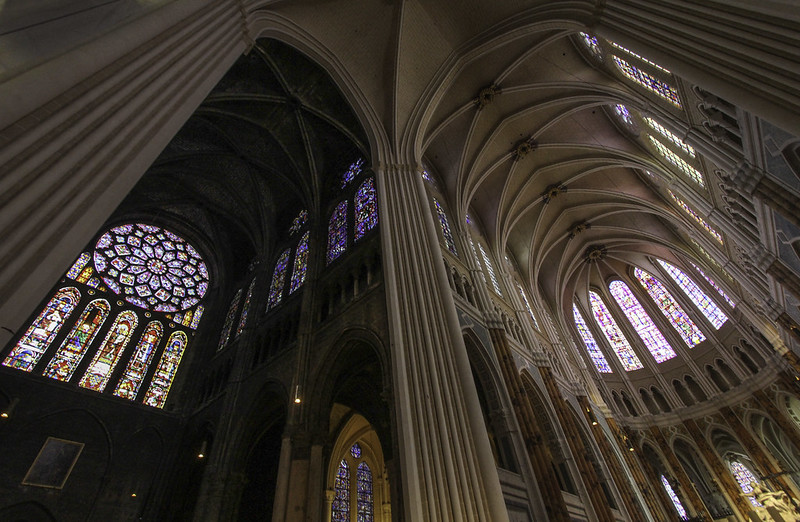
First, why the controversy? (In case you look at the photo and simply think, "how nice, they've cleaned it up.") The NYR article gives one explanation of what's going on here, but it is not a matter of cleaning. The reasoning behind the apparently drastic change is that there is now substantial evidence that there was paint on the stonework at one time. A 2009 article in The Independent goes into a bit more detail about the this evidence. But as Martin Filler points out, the chemical compositions of the paint are unknown, so it is impossible to know how the paint would have been in its original state. And there is reason (founded or not) to doubt that the current scheme is anywhere near the character of the 13th century original.
The point about the impact of electric lighting is an excellent one. Even if this polychrome scheme were completely authentic, viewing it in full light would be a dramatically different experience of it. It is not enough to merely restore the surface without considering the fullness of architectural experience. (How far does that go? Should we also be discussing restoration of the Gallic Rite?) The overall level of lighting is a problem in churches generally. The vast majority of churches are over-lit to the point of meaningless dilution. Instead, lighting should be a tool to reinforce the hierarchy of the interior and direct focus. Moreover, the symbolic potential of light, which was of principal concern to Abbot Suger (from Pseudo-Dionysius) and the Gothic builders, loses its significance when washed out by indiscriminate floodlights. Light only has perceptible significance amidst darkness, at least until we reach a city which needs no light (Rev 21:23).
There are two phases to consider: one of potentiality and one of actuality. It is one thing to say that the interior was originally painted and quite another to actually do it. With a work of art--in the sense of a work where evidence of the hand of the artist is a more integral component and the width of a single brush stroke is a larger percentage of the whole--someone else adding to the work would be doubted even more. But the stark contrast contributes to the reactions. And that would be true regardless of whether the change is correct or not. The reaction is to the change itself, a reaction which always seems to be exaggerated when it comes to church architecture.
The severity of the painting also seems the more drastic as we watch the steady improvement of more ephemeral means of reconstruction such as digital reconstructions and augmented reality. A perfect example is found by walking outside Chartres Cathedral where light projections on the exterior of Chartres Cathedral which can both give the impression of polychromatic reconstructions even without the degree of certainty required of actually applying paint ...
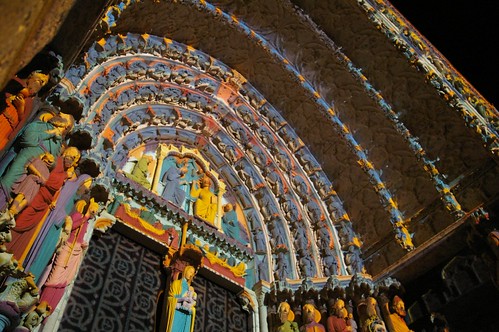
... or create an entirely new experience of the building ...
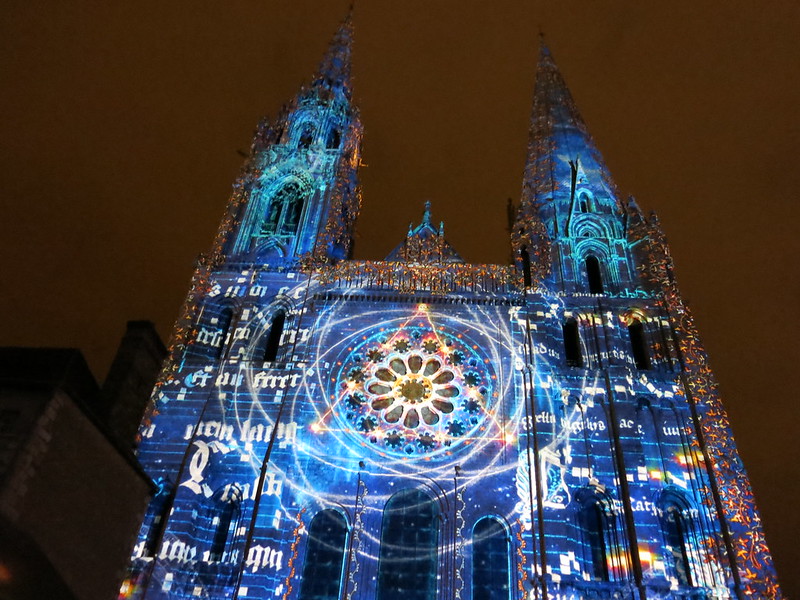
... without permanently altering the structure.
There have been many different theories of historic preservation over time and conflicting approaches today that all need to be mapped out to fully understand what has happened at Chartres over the years and what is happening now before we can really have a discussion about what should be happening. Unfortunately, I'm not well-versed enough in that complexity to provide such a framework here.
If you're interested in the dramatic potential of artistic rehabilitation, I recommend the book Dark Water: Flood and Redemption in the City of Masterpieces, which left me intrigued but of many minds about the proper approach. The restoration of the Cimabue Crucifix described in the book attempted to balance restoration of the experience of the work without negating the event of its damage. The impulse is not unlike the Japanese technique Kintsukuroi or Kintsugi (lit. golden joinery), and in general an aesthetic reference that embraces (authentic) weather, imperfection, and decay. In architecture, Kintsugi has its analogs in works such as the reconstruction of Frauenkirche, Dresden (though the distinction will likely fade with time) and the Neues Museum project. Both case have an obvious interest in not obscuring the damage of the past.

But Chartres is not a matter of restoration after disaster. So to take a dramatic action seems to come from nowhere. Or compare the recently unveiled facade of St Patrick Cathedral, New York which began as preventative maintenance to maintain the integrity of the stone.
But I think the real reason the work in Chartres is so shocking is that we have had a few centuries of the sublime austerity of the raw structure exerting a dominating influence on culture. Each generation brought about a new interpretations of existing works of architecture; most of these away from valuing the colorful Chartres for different reasons at each stage. Here are a few episodes that are influencing critical assessments of the Chartres work.
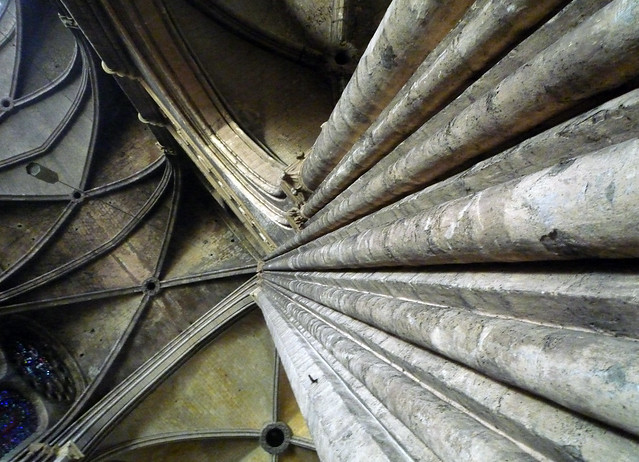
The Reformation brought with it an iconoclasm in varying degrees in different places; more generally the aesthetic influence of Protestantism led to greater restraint in imagery. Except where it didn't and instead inspired the exuberance of the Counter-Reformation, an equally extreme reaction in the other direction which Included the addition of Baroque sculptures, chapels, and altar pieces to older Romanesque and Gothic churches. This happened at Chartres (more on that later).
A later political iconoclasm accompanied the French Revolution, with the prototypical French Gothic church at St Denis among its victims. Fortunately, Chartres Cathedral fared both of these relatively well.
With the 18th century came the rise of an austere Neoclassicism as the standard of culture and taste. Johann Joachim Winckelmann praised the "noble simplicity and quiet grandeur" of the pure white forms of Greek sculpture as the pinnacle of ancient art and the highest model for imitation (though not slavish copying) for contemporary works. Winckelmann was either unaware of the importance of color in the sculpture of the Ancient Greeks (and their temples) or chose to ignore what evidence remained as perversions of the perfection of form and line. (He was also working more from copies of Greek sculpture.)
This was the original Polychrome Controversy, and more to the point of our discussion here, it extended to the temple buildings themselves which like the statues were originally painted. It is hard not to see the reaction against the work at Chartres as a parallel, at least insofar as the expectation for the Gothic cathedral is as an expression of purity of form. The familiarity of of the gray stone facades makes it as difficult for us to imagine them otherwise, just as the white marble would have seemed natural to those primitive archeologists. It at least must be a cautionary tale.
Of course while exhibits of colorful replicas of Grecian sculptures based in high tech chromatic analysis are not uncommon, we don't tend to see people painting the originals. Is it (and should it be) different for buildings? The preservation or conservation or restoration or reconstruction (and what precisely these terms mean to different people) is more complicated with buildings, especially when they remain in active use. Statues remain what they are, but for a building in use to remain what it is, it must change. When I see the liturgical artifacts in the treasury of the cloisters, it is possible to appreciate their material form and the craft of their making. But it is a bit like observing a taxidermied animal stuffed and posed instead of in the wild. Buildings are closer to a craft than an art in this regard, which makes their preservation more difficult.
It is not surprising that the Gothic was held in disdain for those who followed Winckelmann. Nonetheless, the subsequent repetition of the "pure form" version of Neoclassicism (think the Louvre; Washington, D.C.; St Paul Cathedral, London... all definitively cultural behemoths) also would have tinted the appreciation of a gothic structures especially since by this time many would have either lost their color to time or the active removal of the Reformation iconoclasm.
Working from better archeological information than Winckelmann (and in fairness we should probably say from information only possible because of His pioneering work), Gottfried Semper was among the apologists for a polychrome antiquity. In the 1834 pamphlet Preliminary Remarks on Polychrome Architecture and Sculpture in Antiquity, Semper acknowledged the taste for monochromatic while challenging its assumption: "The frequent abuses so easily made in painting and coloring should not be a reason to ban all color and simply to declare garish everything that is not gray, white, or pale earth."
Semper gave four reasons for the validity of color in architecture. The first two appealed more to aesthetics: a reduction in glare and inherent human appreciation of color. The second two reasons spoke more to why color is not foreign or superfluous to buildings: it is the result of necessary protective coatings and materials, and it is an integral component of the aesthetic whole which helps give a building its meaning.
As archeology progressed (for better or worse) and the grand tour became more common, attitudes toward historical forms shifted. One result was the proliferation of what we now consider scandalous archeology, a shady antiquities trade, and speculative reconstructions. How much does the desire to not repeat these mistakes play into the reactions against the Chartres effort?
Another result was that tastes shifted again. The 19th century saw a rise in stylist eclecticism generally and the gothic specifically gave us both the architectural Gothic Revival and the Romantic / Victorian Gothic literature. The prevailing image of Gothic as dark and brooding originated there. The interrelations of these movements and the contradicting motivations for reviving or alluding to medieval life were complex; here we are only concerned with the remnants that have remained to influence the interpretations of our experiences in Gothic churches.
Gothic Revival architecture occurred in both the literary monochromatic:
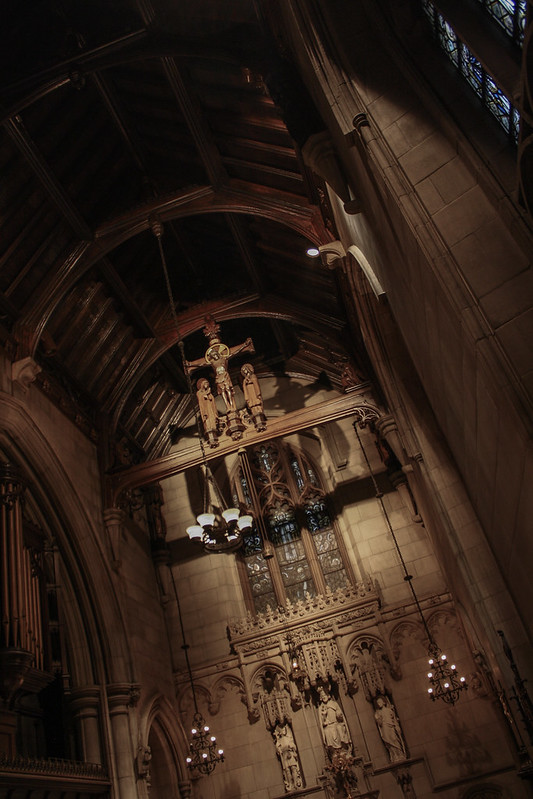
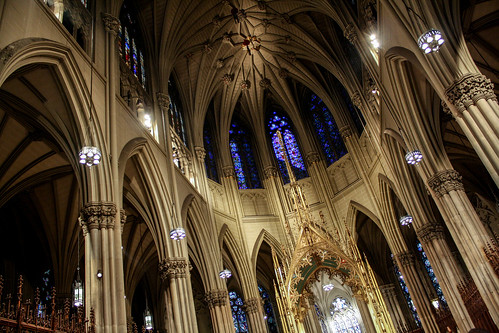
and the richly adorned polychromatic:
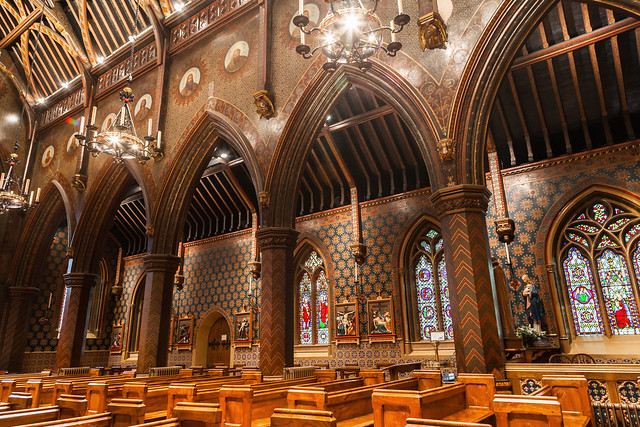
The colored Gothic Revival churches were still somewhat subdued and restrained. The patterns were a combination of paint, masonry, and mosiac, in keeping with the more integrated approach to ornament of pre-modern architecture. And to express its integration into the fabric of the building, it occurred on the interior and exterior, given the propriety of each location:
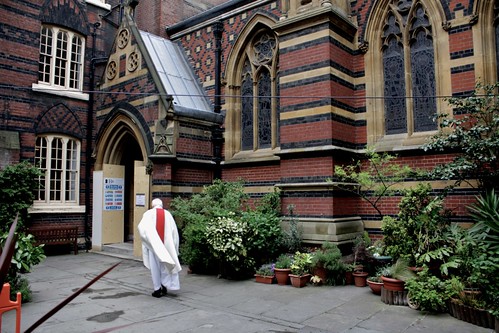
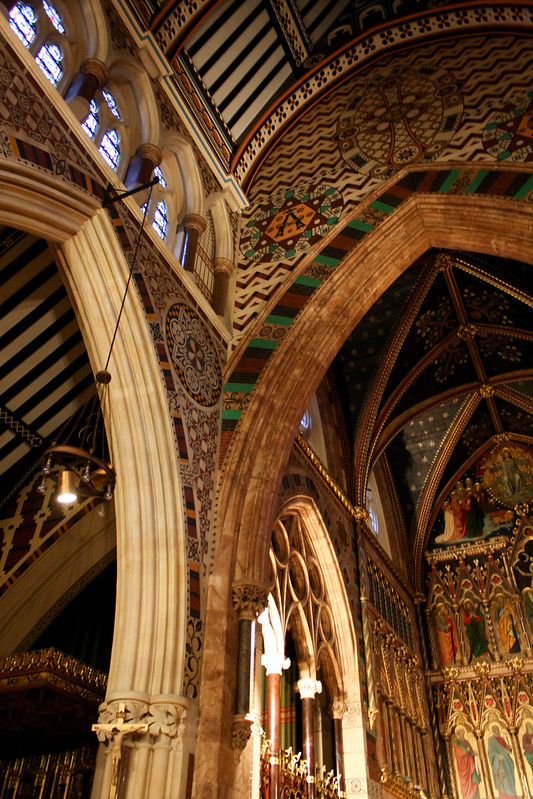
Looking through potential examples of both monochrome and polychrome Gothic Revival churches, I can't help notice that the latter are more common among those who were concerned with not only restoring the architecture of the Middle Aged but also the liturgical and ecclesial practices: Pugin, Butterfield, the Cambridge Camden Society/Ecclesiological Society, etc. In contrast, the raw stone versions tend to be those buildings more concerned with their status in the urban (and social) fabric: Renwick, Scott, etc. The distinction also falls along high (Anglo-Catholic and Roman Catholic) and broad (Episcopal and broad Anglican) church lines.
In the 20th century, the Gothic church took on a new significance with emphasis on the structural honesty of its tectonic expression. This phase had its origins in Eugène Viollet-le-Duc approaching Gothic Revival predominantly through the lens of structure. (He was also a creative/controversial restorer of Gothic structures himself.) So even amidst the (over-emphasized) anti-historical components of 20th century modernism, the structural expression of medieval architecture left a foothold for appreciation.
As the modern emphases on minimalism and structure progressed, Cistercian architecture came to prominence. It was given the epithets "Architecture of Light" and "Architecture of Truth," documented poetically in photography of Lucien Hervé, and influenced architects such as Le Corbusier and John Pawson. Although the "beautiful ruin" was at work here to some degree, Cistercian architecture valued the craft of precise stonecutting as and kept plastering and painting to an minimum, so the ruined monasteries were not very different from their original state. In St Bernard of Claivaux's Apologia, the founder of the order gave his arguments against the vanity of lavishly adorned churches. It was a conclusion that rang true with many 20th century designers, even if the reasons were different.
The fact that extant Cluniac monasteries, striped of their gold and painted ornament, resembled Cistercian monasteries meant that the Cistercian version of medieval architecture became the expected image. So the reaction that Chartres does no look "Medieval enough" might also contain a dubious conception of what Medieval should look like as it filtered through centuries of reinterpretation.
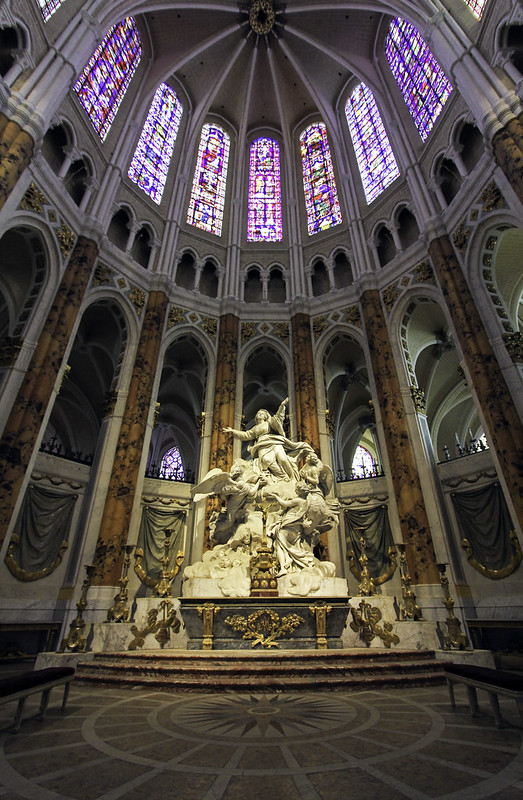
But the greatest part of the striking incongruity of the images in the all of restoration coverage is the view within the chancel toward the high altar. The effect there with the marbling of the columns and the dramatically active carving of the Assumption looks distinctively Baroque. Which it is, though that fact is not addressed in any of the coverage of the restoration work I have seen.
So really the greatest offense to the integrity of the medieval fabric of the cathedral occurred around the 1750s. It is difficult to find much reference to the altar and choir renovations in the historical summaries, almost as if it is embarrassing. There is one balanced account in Cecil Headlam, The Story of Chartres (London: Dent, 1902):
"The Chapter, about 1750, was composed of men with much taste, all of it bad. A terrible mania for ugliness had seized mankind. Men like Bossuet, Fénelon, Montesqieu and Racine, enamored of the classical style, declared the Gothic barbarous. At that inopportune time crisis of taste the Chapter began to 'decorate' the choir. The result is simply nauseating. … Italians were sent for from Milan to wash the grand old stone of Berchères a sickly yellow; the noble simplicity of the piers, capitals and soffits of the arches disappeared beneath a mess of stucco, gilding and sham marble. The choir was treated like an eighteenth century drawing room."
In addition to illustrating the vigour debates about the Gothic stir up, this passage suggests that the author viewed covering the "grand old stone" as an offense, as he would have been unaware of the original medieval paint.
Again, the view of the choir is the emotional hook of the critique (at least for me), and there is no indication that the reason for the incongruity of the choir and the medieval cathedral has nothing to do with recreating a medieval color scheme. It also makes the assertion in the New Liturgical Movement article that what you see now is what has been there for 800 years false and a bit silly. There has been paint for 800 years, but it's appearance has changed dramatically over that time and been replaced with reconstructions. There have been reconstructions after fires and various reorderings and changes throughout the building's history. All of this brings us back to the question of the period of significance, the idea of the building as a living entity, and ship of Theseus paradox.
For comparison, here are some examples of what I expect to see in medieval polychrome. First, a nice example from Amiens, a relief of Jesus Cleansing the Temple dated ca. 1527 (a full 300 years after the completion of Chartres).
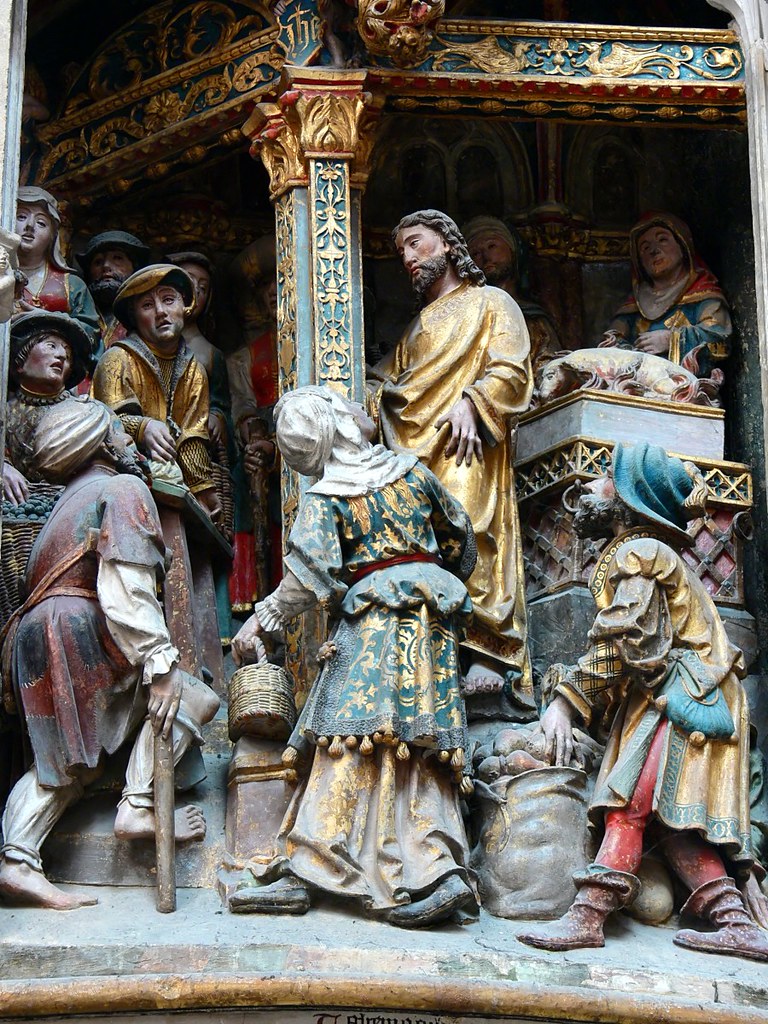
It is interesting to look at what parts of the buildings are depicted as painted and unpainted in the representation of the Temple as a Gothic church. The columns and ribbing certainly stand out and there is certainly the gilding Headlam balked at. It is difficult to discern the treatment of the infill panels, but they are certainly more plain.
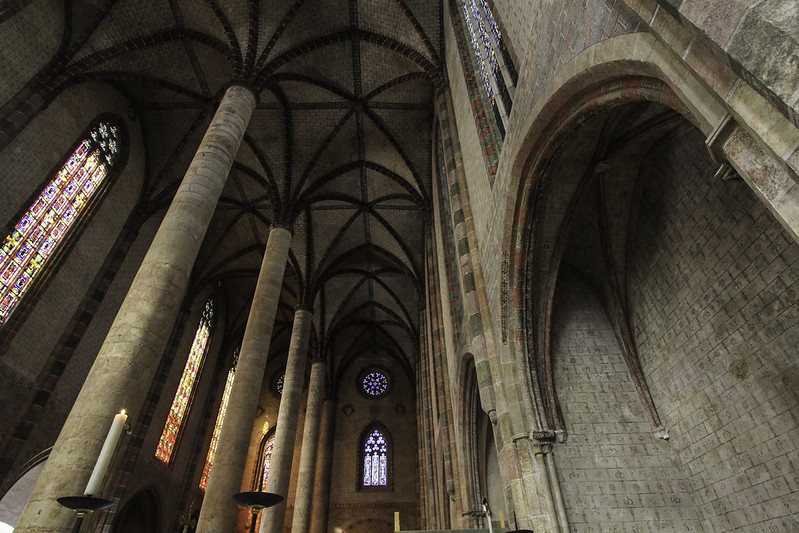
In general, the painting shown accentuates rather than conceals the underlying structure. This suggests that color was not considered an additional element. Whereas by the time of the baroque altar color was a tool for a transformative effect used to give the impression of a an entirely different type of stone. We see the early stages of the ability to conceive of structure and ornament as separate entities.
But can the painting still be considered integral to the structure even when the painters "perfected" the pattern of stonework such that it differs from the actual masonry? According to an article in the Independent, one technique uncovered was a "white pattern of "fake" stone joints, which do not follow the lines of the real masonry. They were painted on to give the walls a more uniform look." This is visible in photos of the choir, but the article suggests it is a medieval technique.
As I've been visiting the Painted Churches, I've been trying to resolve the tension (from a modern perspective) of paint as a material and the principle of material honesty. Is paint by its nature dishonest and concealing? Or can it be viewed as an integral component of architecture, based on various notions of authenticity?
Consider these examples with the obvious disclaimer that I don't know the extent of restoration done on them and therefore the authenticity to their original state. But is authenticity to the original intent the only authenticity that matters? Consider the absolutely gorgeous texture remnant on the back of Our Lady's robes on this Medieval sculpture in the Cloisters museum:
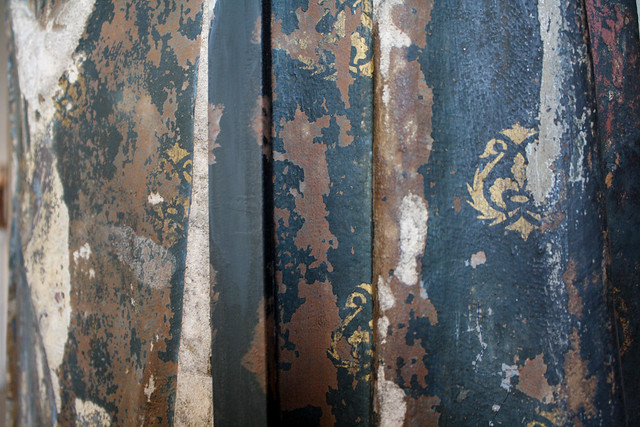
The current craving for authenticity (see The Dream of the 1890s is Alive in Portland) would value and benefit from imminent antiquity. In material terms, the kind of actual weathering that reveals the longevity (and suggests the continuity) of the church's worship. The active use of ancient structures represents better than anything else the permanence and yet impermanence that is characteristic of the church in our age, the already but not yet. That continued reuse makes renovation and restoration necessary, but at the same time values the narrative contained the natural decay of material and structure. For a culture that wants to ignore death and decay and whose architecture reveals its hubris, this lesson is all the more valuable, especially on artifacts whose craft allow for beautiful (and useful) ruins.
The question of the apparent authenticity of paint also depends on the particular technique and execution. In the case of Chartres, the moment that puts it over the top is the marbling of the columns.

As we have seen, this was most likely an 18th century technique. In the Painted Churches too this is my least favorite technique, but there is something less offensive about marbling a wood column in the context of a fully painted interior where all of the patterns derive from the underlying structure.
And there is something to be said for the whole component painted as a single unit. As a local example that is entirely unacceptable, I recently came across the inexplicable painting of a faux green marble square inset on a veneer of yellow marble, complete with beveling and shadows. So it could be worse?
Again, this is only an attempt to put into play some important issues that have been missing from what has been a fairly shallow discussion. Those better versed in the range of approaches to historic buildings. But this is clearly not the restoration to a single original state that it is being presented as by those involved with the work. Nor is it quite the ruination the critiques present.
The critiques of the restoration work at Chartres are ultimately an emotional response to the loss of a particular beloved experience of the cathedral and is based on centuries of changing attitudes toward and conceptions of the masterpieces of Medieval architecture. But they are also based on a simplified version of the building's history that fails to take into account the complex and dynamic interior life of the building. We could also (and must also) relate the various changes made to the building to the changes from the medieval liturgical practices, the Gallic Rite, it suppression, the rise of the Tridentine form of the Latin Rite, its development (as it corresponds to the 1750s alterations), and its continued use as a Cathedral. For we must remember that this is not just the cultural monument at Chartres, but the Cathedral Basilica of Our Lady of Chartres.

